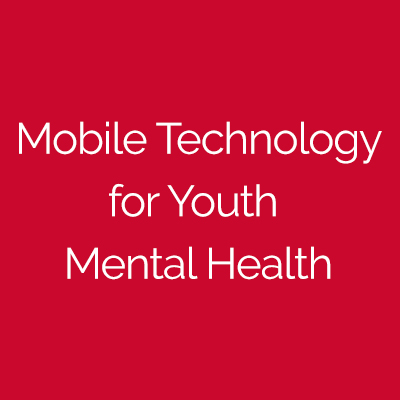Interdisciplinary, innovative approach in mobile technology can help children and adolescents overcome depression and anxiety
Globally, depression and anxiety are the two leading causes of daily life impairment to school, family, and work amongst non-fatal diseases. Onset and burden peak before the age of 25 years, yet the large minority of those who need mental health services never receive care. This is particularly true for children and adolescents for whom the risk of stigma and lack of access to care present significant barriers. The Mobile Technology for Youth Mental Health Initiative, at Rutgers University, aims to leverage advances in mobile technology and wearable sensors to create a suite of assessment and treatment tools that can be broadly disseminated to consumer markets, to understand, prevent, and treat child and adolescent anxiety and depression. By meeting kids where they are -- tethered to smartphones and digital devices -- researchers at the Initiative hope to help kids learn more about themselves and become their own best coping coach.
An interdisciplinary collaboration between renowned researchers, the Initiative was designed and launched in 2013 when Dr. Yanyong Zhang, Professor of Computer Engineering who was working on mobile phone applications to naturalistically detect how many people were speaking in the proximity of the user’s phone, met with Dr. Brian Chu, Professor of Clinical Psychology. As symptoms of depression and anxiety include isolation and withdrawal from activities, Dr. Chu had been working on a phone diary system that aimed to help children assess their own behavioral patterns of isolation and avoidance. These efforts and expertise combined with the knowledge of Dr. Clifford Weisel, Professor of Environmental and Occupational Health Sciences and Dr. Mehdi Javanmard, Professor of Electrical and Computer Engineering, the Mobile Technology for Youth Mental Health Initiative can develop a comprehensive assessment suite to help understand how kids really act, behave, and respond when they feel anxious or depressed. The evaluation process encompasses environmental, biological, and behavioral markers of youth distress heretofore unknowable, and will help create a personalized intervention tool that makes individualized coping recommendations based on one’s personal environmental-bio-behavioral context and risk factors.
Current research includes:
- Environmental Exposure: Dr. Weisel studies the different kinds of environmental pollutants and other exposures that often trigger biological responses. With their expertise, the Initiative aims to develop stationary and portable sensors that measure neurotoxin exposure (e.g., particulate matter, oxidants, volatile organic compounds, food and drinks consumed) related to anxiety and mood.
- Biomarkers of Anxiety and Mood Disorders: When people are stressed or anxious, they send off recognizable biological vibes, like their heart beating faster or body producing chemicals like cortisol that identifies with stress. Stress or anxiety also yields an inflammatory response (e.g., cytokines) that many people get when they are sick, as the body develops cytokines as a way to activate the immune system. Dr. Javanmard is interested in mobile sensors that detect these biological changes in the body, like sweat and saliva.
- Psycho-behavioral: Dr. Chu’s research and expertise lies in the understanding of socio-emotional behaviors that distinguish healthy from distressed episodes in youth. Some of this research include: identifying the contexts (e.g., interpersonal, performance, psychological) and socio-behavioral responses (e.g., avoidance, isolation, aggression) that trigger and maintain emotional distress. Dr. Zhang’s work enables the group to apply cutting-edge technology to address the problem, in the form of wireless networks and mobile applications.

Bio
Brian Chu, Ph.D. was always interested in what made people work, and as he got into psychology, he was mostly invested in helping children and adolescents where an ounce of prevention can equal a pound of cure. In particular, anxiety and depression affect more youth under 18-years old than any other mental health issue. And yet, these kids often keep to themselves – they’re the “silent sufferers” in the bunch. And they hold themselves back in many ways – they resist from asking for help in school, they withdraw from friends and family, they avoid opportunities that are fulfilling but stressful in the moment. Helping kids achieve very simple milestones - like going to class, accepting an invitation to a party, trying out for a play – can have huge impact on their ultimate developmental trajectories. Small victories early on can mean freedom to make more meaningful choices later on.
http://gsappweb.rutgers.edu/facstaff/dynamic/profile.php?ID=35 and http://yadc.rutgers.edu
Yanyong Zhang, Ph.D. was always interested in computer- and communication-related technologies that could improve one’s life. Since she started her research career in 1997, she has studied many different networked systems such as servers, sensor networks, sensors, and mobile devices such as smartphones and smart wearable devices. In particular, when she joined the project, she was interested in monitoring a user’s physical activity level and emotional well-being using smartphones. That is, through built-in smartphone sensors, she could monitor a youth’s location, motion pattern, and physical activity level, which can serve as indicators for his/her emotional well-being. In addition, she was also developing smartphone apps that can monitor and analyze a youth’s conversations, thus inferring important information such as whether a youth is regularly talking to other kids, how many other kids the youth is regularly talking to, and how engaged he/she is in a conversation. As a result, Dr. Zhang believes that smartphones can be used to assess a kid’s emotional wellbeing.
http://www.ece.rutgers.edu/~yyzhang/
Understanding the environment around him is an innate part of his life even though he grew up in Brooklyn, NY – a highly urban setting. Dr. Weisel remembers being thrilled to be one of a few children to be taken on a trip by his fifth grade teacher to a park two hours away where they walked through marshes and tall grass, even though it meant getting up as early as 6 am on a Sunday morning. He has always had environmentalist bent, with an idea to save our planet. As he progressed through his education Dr. Weisel found that his talents for analyzing problems was particularly suited to chemistry. He has since combined these interests to develop a research program on chemicals in the environment and for the last 25 years been involved in helping to develop the field of exposure science – which seeks to understand how people are exposed to chemicals in the environment and their potential health effects. He has joined this team to apply the principles of exposure science to begin to understand the role of chemical exposure on anxiety in youth, an area that has not yet been explored. Being able to determine how the external environment, ranging from the air breathed to contaminants or nutrition in the food consumed, affects a child’s and adolescent’s emotional state can provide an insight into steps that can be taken to improve their lives and social interactions.
http://eohsi.rutgers.edu/eohsi-directory/name/clifford-weisel/
Mehdi Javanmard, Ph.D. was always interested in building tools and gadgets useful for helping people and improving quality of life, particularly in the context of patient care. The idea, that molecular information in biological samples like blood, sweat, and saliva can be used to rapidly diagnose patients and monitor the health of individuals has been the driving force motivating him to build tools that are smaller, cheaper, faster, higher throughput, and more sensitive than current gold standard instruments used in the clinical setting. Over the last 12 years, he has focused on exploiting his background in electrical engineering and nanotechnology to build devices and tiny chips that can analyze biomolecular indicators in bodily samples. His ultimate goal is to develop wearable devices that can continuously monitor molecular information and provide real time information regarding patient health. He joined this team with the goal of applying these same wearable molecular technologies for monitoring mental health as well. Being able to monitor the relevant markers in youth continuously in real time can not only provide extra insight regarding the molecular mechanisms involved in emotional states, but can also be valuable for predicting and thus preventing the onset of anxiety attacks as well. http://www.ece.rutgers.edu/Javanmard
In the News
My Central Jersey
Publications
Awards
Klingenstein Third Generation Foundation Young Investigator’s Award, 2009
NSF CAREER Award, 2006
Patents
U.S. Patent No. 08/101,260: “Wipe Template Sampler”
Granted 1994 to Paul Lioy and Clifford Weisel


